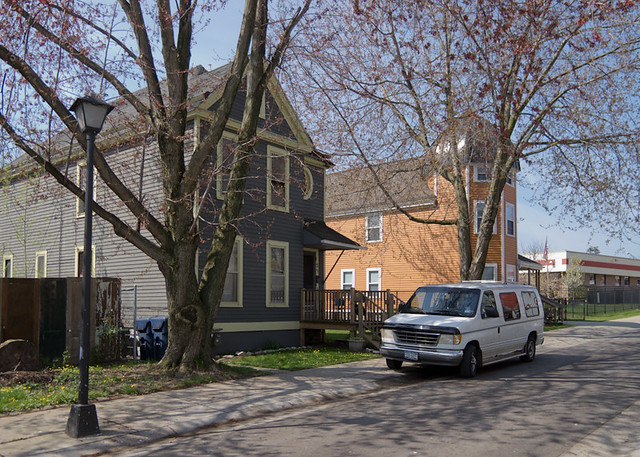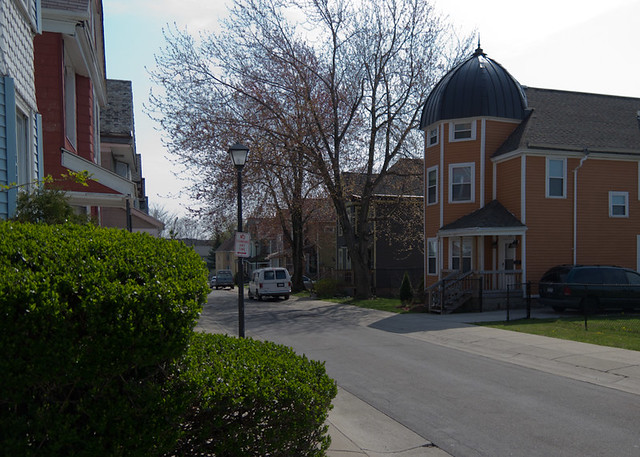Coe Place might still be a roller skating rink if it hadn’t been so “far out.” If you know where Coe Place is, you are likely to lift up your eyebrows at that. For a location between Main and Ellicott one block north of Summer Street would draw a “convenient to store and theaters” line from any real estate company now.
But during the five years between 1885 and 1890 that part of town was in the hinterlands. Horse car service was not everything one could desire in the way of transportation and trade on the skating rink was not so good. So George A. Chadeayne who owned the rink decided he’d build a street. People needed houses worse than they needed places to skate.
Chadeayne, white haired and white-bearded, lives at 1175 Delaware now. I went to see him. I was rather thrilled by the idea of talking with a man who once owned a street. He told me all about it. The sailing wasn’t so smooth at first. Some of the people round about didn’t want any street. They had some lawsuits about it, but while the lawsuits were pending Chadeayne went ahead and built seven houses on the north side of the street. He won the suit and sold the houses, but by this time winter was coming on.
 |
| Two remaining trees that once formed a tree canopy over Coe Place |
“I bought the whole strip, 100 feet wide all the way through from Main to Ellicott for $12,500,” Chadeayne said. “I sold the corner lot for $16,000 later. The man who bought it was once offered $100,000, he told me, and refused.” By a marvel of skillful Gerrymandering, every lot was given two or three or five feet of frontage on either Main or Ellicott, and deeded on one street or the other. Posts were put up at the ends, brick pavement was laid, and the new street was ready. Chadeayne named it for his father-in-law, William S. Coe.
And Coe Place remained a private street until July a year ago. In the course of the years the brick pavement had become full of cracks, and dips and bumps. The water pipes were small and antiquated. Worse than that all gas was used for lighting purposes was turned off, and every street lamp on Coe Place was a gas light. After five weeks of darkness, the women decided something had to be done.
So Mrs. Louis Fitzpatrick, who lives at No. 33, and Mrs. Thomas H. Chittenden who lives at No. 25 went to see the city council. The people signed petitions. And the city gave over Coe Place, gave it new plumbing, electric lights, and a concrete pavement.
Mrs. Fitzpatrick, who has owned a house on the street 28 years claims the longest residence. Among those who had lived on the street in that time and who have attained prominence, Mrs. Fitzpatrick remembers Hamilton Ward, attorney general of New York, whose home was at No. 19. The younger generation on the street is mostly boys. Buddy Kraft, son of E.V. Kraft, at No. 35; Norman, Edward, George and Billy Koehler, sons of Frank Koehler at No. 23; Thomas Chittenden jr, at No. 25; and Richmond Steele jr, at the corner of Ellicott and Coe, comprises the gang. They hold their secret rites in the back yard of No. 35.
Arline and Joyce Hostetler are the only girls on Coe Place, but they have curls, and they can sing, so the gang speaks highly of them, even though they are “just girls” and a little young at that for the rest of the bunch – who all go back to school today.
To see all the photos from Coe Place click here or to see them as a slideshow click here.
 |
| 1889 Sanborn Map depicting the skating rank and the first seven houses before Coe Place was even a street |
To see all the photos from Coe Place click here or to see them as a slideshow click here.
_________________________________________________________________________________________________



No comments:
Post a Comment